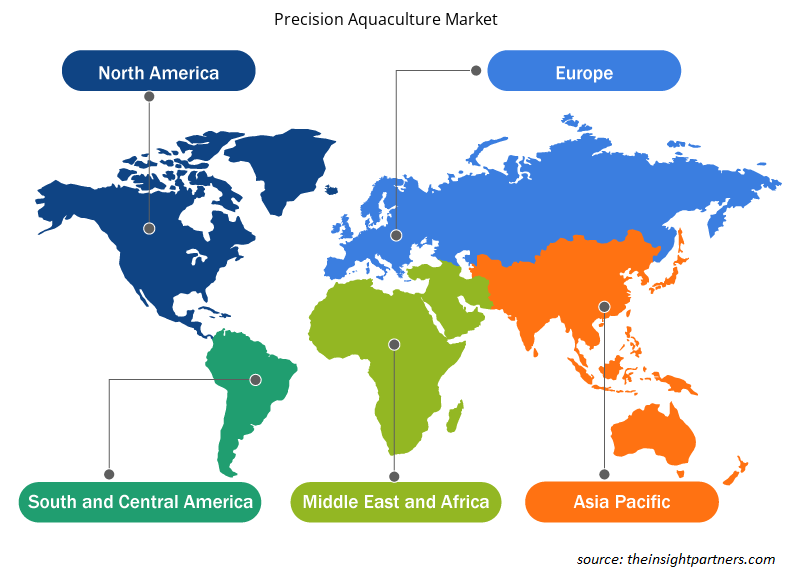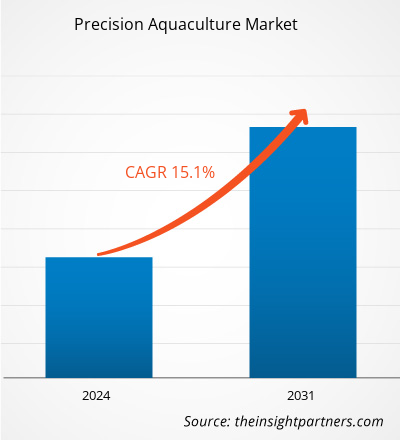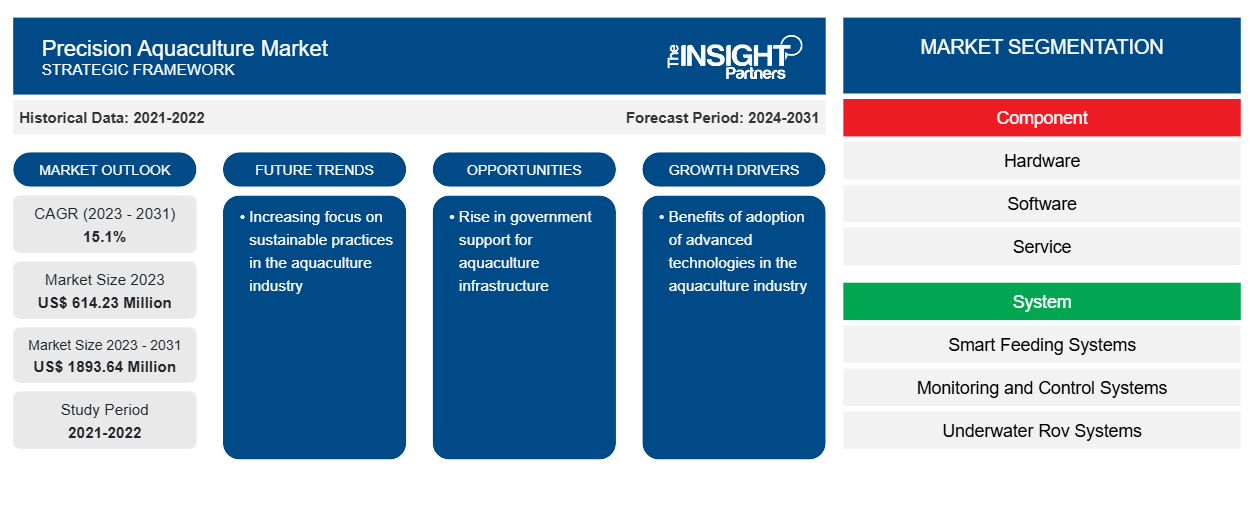Der Markt für Präzisionsaquakultur soll von 614,23 Millionen US-Dollar im Jahr 2023 auf 1893,64 Millionen US-Dollar im Jahr 2031 anwachsen. Der Markt wird zwischen 2023 und 2031 voraussichtlich eine durchschnittliche jährliche Wachstumsrate von 15,1 % verzeichnen. Der Anstieg der Investitionen in die Aquakulturinfrastruktur und die zunehmende Einführung von IoT-Lösungen in der Aquakulturbranche dürften weiterhin wichtige Trends auf dem Markt bleiben.
Präzisions-Aquakultur-Marktanalyse
Der zunehmende Einsatz von KI, IoT und ROV in der Aquakultur ist einer der Hauptfaktoren, die das Marktwachstum vorantreiben. Der wachsende Fokus und die Investitionen der Regierung in die Entwicklung der Aquakulturinfrastruktur treiben das Marktwachstum voran. Der Beitrag präziser Aquakulturtechniken zur nachhaltigen Meeresfrüchteproduktion und zur Befriedigung der weltweiten Nachfrage nach Wasserprodukten treibt das Marktwachstum weiter an.
Marktübersicht zur Präzisionsaquakultur
Die Aquakulturindustrie erlebt in großem Umfang den Einsatz von Geräten des Internets der Dinge (IoT), um ihre Farmen zu modernisieren und datengesteuerte Entscheidungen zu treffen. Die Präzisionsaquakultur nutzt vernetzte Sensoren und Software in der Meeresumwelt, um Aquafarmbetriebe zu überwachen, zu analysieren, zu interpretieren und Entscheidungshilfen bereitzustellen. Das datenbasierte Aquakultursystem hilft den Betreibern der Aquaindustrie, ihre Produktivität zu steigern.
Passen Sie diesen Bericht Ihren Anforderungen an
Sie erhalten kostenlose Anpassungen an jedem Bericht, einschließlich Teilen dieses Berichts oder einer Analyse auf Länderebene, eines Excel-Datenpakets sowie tolle Angebote und Rabatte für Start-ups und Universitäten.
-
Holen Sie sich die wichtigsten Markttrends aus diesem Bericht.Dieses KOSTENLOSE Beispiel umfasst eine Datenanalyse von Markttrends bis hin zu Schätzungen und Prognosen.
Treiber und Chancen des Marktes für Präzisionsaquakultur
Vorteile der Einführung fortschrittlicher Technologien in der Aquakulturindustrie zur Förderung des Marktes
Die Aquakulturbranche steht vor Herausforderungen wie steigenden Futter- und Energiekosten, Umweltbedrohungen, Produktionsineffizienzen und anderen. Um diese Herausforderungen zu bewältigen, verwendet die Branche Sensoren, Kameras, künstliche Intelligenz, Cloud-Technologien und verschiedene andere Lösungen, um auf der Grundlage der Daten beispiellose Erkenntnisse zu gewinnen, was zu einem Wachstum des Marktes für Präzisionsaquakultur führt. Darüber hinaus bieten die Marktteilnehmer den Marktteilnehmern der Aquakulturbranche Lösungen an. Beispielsweise helfen die Präzisionsaquakulturtechnologien von Innovasea Aquakulturbetreibern, ihre Abläufe auf der Grundlage zuverlässiger Echtzeitdaten genau zu überwachen, zu verwalten und zu kontrollieren. Sie helfen den Betreibern bei der besseren Entscheidungsfindung, um ihre Gewinne zu steigern und nachhaltiger zu werden.Innovasea’s precision aquaculture technologies help aquaculture operators to closely monitor, manage and control their operations based on reliable real-time data. It helps the operators with better decision-making to boost profits and become more sustainable.
Steigende staatliche Unterstützung für Aquakultur-Infrastruktur
Der zunehmende Trend zum intelligenten Fischfang und das Wachstum im Fischhandel erhöhen die Nachfrage nach Produkten, die für den Aufbau der Aquakulturinfrastruktur erforderlich sind. Veränderungen im weltweiten Lebensmittelkonsum tragen ebenfalls zur Expansion und Diversifizierung dieser Branche bei. Darüber hinaus treiben das Wachstum des Einzelhandels und die leichte Verfügbarkeit von Aquakulturprodukten über zahlreiche Kanäle den Verkauf dieser Produkte an. Das kräftige und kontinuierliche Wachstum der Aquakultur in verschiedenen bedeutenden Ländern wie Norwegen, China, Indien und Indonesien treibt den globalen Markt für Präzisionsaquakultur an.
Segmentierungsanalyse des Marktberichts zur Präzisionsaquakultur
Wichtige Segmente, die zur Ableitung der Marktanalyse für Präzisionsaquakultur beigetragen haben, sind Komponente, System und Anwendung.
- Basierend auf den Komponenten ist der Markt für Präzisionsaquakultur in Hardware, Software und Service unterteilt. Das Hardwaresegment hatte im Jahr 2023 den größten Marktanteil.
- Nach System ist der Markt in intelligente Fütterungssysteme, Überwachungs- und Kontrollsysteme, Unterwasser-Rov-Systeme und andere unterteilt. Die intelligenten Fütterungssysteme hielten im Jahr 2023 einen erheblichen Marktanteil.Rov systems, and others. The smart feeding systems held a significant share of the market in 2023.
- Nach Anwendung ist der Markt in Betrugserkennung und -prävention, Governance Risk & Compliance (GRC), Customer Experience Management, vorausschauende Wartung, Supply Chain Management, Bedrohungsinformationen und andere unterteilt. Das Customer Experience Management hatte im Jahr 2023 einen erheblichen Marktanteil.GRC), customer experience management, predictive maintenance, supply chain management, threat intelligence, and others. The customer experience management held a significant share of the market in 2023.
Marktanteilsanalyse für Präzisionsaquakultur nach geografischer Lage
Der geografische Umfang des Marktberichts zur Präzisionsaquakultur ist hauptsächlich in fünf Regionen unterteilt: Nordamerika, Asien-Pazifik, Europa, Naher Osten und Afrika sowie Süd- und Mittelamerika.
Europa wird im Prognosezeitraum voraussichtlich eine signifikante durchschnittliche jährliche Wachstumsrate aufweisen. Der Anstieg der Digitalisierung und die wachsende Nachfrage nach fortschrittlichen Datenanalysetechniken in der Region treiben das Marktwachstum an. Darüber hinaus treibt der staatliche Fonds zur Förderung der Aquakulturindustrie den Markt an. Beispielsweise zielt der EU-Fonds „Horizon 2020“ auf eine nachhaltige Intensivierung der Aquakultur in Europa ab. Das vom EU-Fonds „Horizon 2020“ finanzierte GAIN-Projekt konzentriert sich auf Präzisionsaquakultur.CAGR in the forecast period. The rise in digitalization and growing demand for advanced data analytics techniques in the region is driving market growth. In addition, the government fund to fuel the aquaculture industry drives the market. For example, the EU Horizon 2020 Fund aimed at sustainable aquaculture intensification in Europe. The GAIN project funded by the EU Horizon 2020 Fund is focused on precision aquaculture.
Regionale Einblicke in den Markt für Präzisionsaquakultur
Die regionalen Trends und Faktoren, die den Markt für Präzisionsaquakultur im Prognosezeitraum beeinflussen, wurden von den Analysten von Insight Partners ausführlich erläutert. In diesem Abschnitt werden auch die Marktsegmente und die Geografie des Marktes für Präzisionsaquakultur in Nordamerika, Europa, im asiatisch-pazifischen Raum, im Nahen Osten und Afrika sowie in Süd- und Mittelamerika erörtert.

- Erhalten Sie regionalspezifische Daten zum Markt für Präzisionsaquakultur
Umfang des Marktberichts zur Präzisionsaquakultur
| Berichtsattribut | Details |
|---|---|
| Marktgröße im Jahr 2023 | 614,23 Millionen US-Dollar |
| Marktgröße bis 2031 | 1893,64 Millionen US-Dollar |
| Globale CAGR (2023 - 2031) | 15,1 % |
| Historische Daten | 2021-2022 |
| Prognosezeitraum | 2024–2031 |
| Abgedeckte Segmente |
Nach Komponente
|
| Abgedeckte Regionen und Länder |
Nordamerika
|
| Marktführer und wichtige Unternehmensprofile |
|
Dichte der Marktteilnehmer für Präzisionsaquakultur: Die Auswirkungen auf die Geschäftsdynamik verstehen
Der Markt für Präzisionsaquakultur wächst rasant, angetrieben durch die steigende Nachfrage der Endnutzer aufgrund von Faktoren wie sich entwickelnden Verbraucherpräferenzen, technologischen Fortschritten und einem größeren Bewusstsein für die Vorteile des Produkts. Mit steigender Nachfrage erweitern Unternehmen ihr Angebot, entwickeln Innovationen, um die Bedürfnisse der Verbraucher zu erfüllen, und nutzen neue Trends, was das Marktwachstum weiter ankurbelt.
Die Marktteilnehmerdichte bezieht sich auf die Verteilung der Firmen oder Unternehmen, die in einem bestimmten Markt oder einer bestimmten Branche tätig sind. Sie gibt an, wie viele Wettbewerber (Marktteilnehmer) in einem bestimmten Marktraum im Verhältnis zu seiner Größe oder seinem gesamten Marktwert präsent sind.
Die wichtigsten auf dem Markt für Präzisionsaquakultur tätige Unternehmen sind:
- AKVA GRUPPE
- Skala AQ
- CHETU INC
- TIEFENTREKKER
- INNOVASEA-SYSTEME
- PENTAIR AES
Haftungsausschluss : Die oben aufgeführten Unternehmen sind nicht in einer bestimmten Reihenfolge aufgeführt.

- Überblick über die wichtigsten Akteure auf dem Markt für Präzisionsaquakultur
Neuigkeiten und aktuelle Entwicklungen zum Markt für Präzisionsaquakultur
Der Markt für Präzisionsaquakultur wird durch die Erhebung qualitativer und quantitativer Daten nach Primär- und Sekundärforschung bewertet, die wichtige Unternehmensveröffentlichungen, Verbandsdaten und Datenbanken umfasst. Nachfolgend sind einige der Entwicklungen auf dem Markt für Präzisionsaquakultur aufgeführt:
- Innovasea, ein weltweit führender Anbieter technologisch fortschrittlicher Lösungen für die Aquakultur und Fischverfolgung, gab bekannt, dass es der chilenischen Aquakulturindustrie nun landgestützte Aquakulturlösungen anbietet. (Quelle: Innovasea, Pressemitteilung, April 2024)
- Skretting Southern Europe hat 360+ auf den Markt gebracht, das bahnbrechende Präzisionslandwirtschaftskonzept, das Fütterungsprotokolle und Produktionsmanagement optimiert und so die Wettbewerbsfähigkeit der mediterranen Aquakultur weiter steigert. Skretting 360+ nutzt die neueste Analysesoftware und andere Industrie 4.0-Technologien, um die Fischproduktion innovativ zu gestalten. Es ist ein Komplettpaket aus präzisionsbasierten Werkzeugen und Dienstleistungen, das Ernährung, Farmmanagementpraktiken und technischen Support sowie hochmoderne Unterwasserkameras und Sensorausrüstung (IoT) umfasst. (Quelle: Skretting, Pressemitteilung, April 2023)
Marktbericht zur Präzisionsaquakultur – Abdeckung und Ergebnisse
Der Bericht „Marktgröße und Prognose für Präzisionsaquakultur (2021–2031)“ bietet eine detaillierte Analyse des Marktes, die die folgenden Bereiche abdeckt:
- Marktgröße und Prognose für Präzisionsaquakultur auf globaler, regionaler und Länderebene für alle wichtigen Marktsegmente, die im Rahmen des Berichts abgedeckt sind
- Markttrends im Bereich der Präzisionsaquakultur sowie Marktdynamiken wie Treiber, Beschränkungen und wichtige Chancen
- Detaillierte PEST/Porters Five Forces- und SWOT-Analyse
- Marktanalyse für Präzisionsaquakultur, die wichtige Markttrends, globale und regionale Rahmenbedingungen, wichtige Akteure, Vorschriften und aktuelle Marktentwicklungen umfasst
- Branchenlandschaft und Wettbewerbsanalyse, einschließlich Marktkonzentration, Heatmap-Analyse, prominenten Akteuren und aktuellen Entwicklungen für den Markt für Präzisionsaquakultur
- Detaillierte Firmenprofile
- Historische Analyse (2 Jahre), Basisjahr, Prognose (7 Jahre) mit CAGR
- PEST- und SWOT-Analyse
- Marktgröße Wert/Volumen – Global, Regional, Land
- Branchen- und Wettbewerbslandschaft
- Excel-Datensatz
Aktuelle Berichte
Erfahrungsberichte
Grund zum Kauf
- Fundierte Entscheidungsfindung
- Marktdynamik verstehen
- Wettbewerbsanalyse
- Kundeneinblicke
- Marktprognosen
- Risikominimierung
- Strategische Planung
- Investitionsbegründung
- Identifizierung neuer Märkte
- Verbesserung von Marketingstrategien
- Steigerung der Betriebseffizienz
- Anpassung an regulatorische Trends























 Kostenlose Probe anfordern für - Markt für Präzisionsaquakultur
Kostenlose Probe anfordern für - Markt für Präzisionsaquakultur